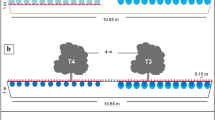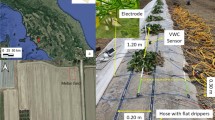Abstract
In situ monitoring of water and salt transport in saline soil is a valuable tool for the rational exploitation and conservation of water and soil resources in coastal areas. In this paper, an automatic monitoring device was used to monitor the vertical variation of soil resistivity during leaching in laboratory and field experiments. The experimental results showed that the resistivity peak moved downwards and eventually disappeared during leaching. An equation describing the change in leaching speed over time was obtained. It was found that the desalination occurred from top to bottom and that the desalination depth was constant when the same volume of leaching fluid was applied. Resistivity indication and salinity content showed a significant exponential correlation (R 2 > 0.9). The field experiment demonstrated the stability of data transmission, and variations in apparent resistivity in one day and over a longer period were observed. Rainfall resulted in the downward migration of salt from surface soil, whereas evaporation led to migration of salt upward. The temporal and spatial resolution of this monitoring device can be adjusted to achieve dynamic monitoring, providing an easy means to manage soil and water conservation.
Similar content being viewed by others
References
Dehaan, R.L.; Taylor, G.R.: Field-derived spectra of salinized soils and vegetation as indicators of irrigation induced soil salinization. Remote Sense Environ. 80, 406–417 (2002)
Dehaan, R.L.; Taylor, G.R.: Image-derived spectral endembers as indicators of salinization. Int. J. Remote Sens. 24(4), 775–794 (2003)
Metternicht, G.I.; Zinck, J.A.: Remote sensing of soil salinity: potentials and constraints. Remote Sense Environ. 85, 1–20 (2003)
Jingsong, Y.: Development and prospect of the research on salt-affected soils in China. Acta Pedologica Sinica 5, 010 (2008)
Hoffman, G.J.: Guidelines for reclamation of salt-affected soils. Appl. Agric. Res. 1, 15–72 (1986)
Friedman, S.P.: Soil properties influencing apparent electrical conductivity: a review. Comput. Electron. Agric. 46(1–3), 45–70 (2005)
Won, I: The geometric factor of a marine resistivity probe with four ring electrodes. J. Ocean. Eng. 12, 301–303 (1987)
Ridd, P.V.: A sediment level sensor for erosion and siltation detection. Estuar. Coastal Shelf Sci. 35(4), 353–362 (1992)
Ridd, P.V.: Electric potential due to a ring electrode. J. Ocean. Eng. 19(3), 464–467 (1994)
Rhoades, J.D.; Corwin, D.L.; Lesch, S.M.: Geospatial measurements of soil electrical conductivity to assess soil salinity and diffuse salt loading from irrigation. Assessment of non-point source pollution in the vadose zone, pp 197–215 (1999)
Hendrickx, J.M.H.; Kachanoski, R.G.: Nonintrusive electromagnetic induction. Methods Soil Anal. Part 4, 1297–1306 (2002)
Gönenç, T.; Timur, E.; Utku, M. et al.: Geophysical investigation of the hematite nones in Koçarlı–Demirtepe (Aydın/Turkey). Arab. J. Sci. Eng. 38(7), 1841–1849 (2013)
Rhoades, J.D.; Ingvalson, R.D.: Determining salinity in field soils with soil resistance measurements. Soil Sci. Soc. Am. 35, 54–60 (1971)
Halvorson, A.D.; Rhoades, J.D.: Assessing soil salinity and identifying potential saline-seep areas with field soil resistance measurements. Soil Sci. Soc. Am. J. 38(4), 576–581 (1974)
Rhoades, J.D.; van Schilfgaarde, J.: An electrical conductivity probe for determining soil salinity. Soil Sci. Soc. Am. 40, 647–650 (1976)
Read, D.W.L.; Cameron, D.R.: Relationship between salinity and Wenner relationship between salinity and Wenner resistivity for dryland soils. Can. J. Soil Sci. 59, 381–385 (1979)
Rhoades, J.D.; Chanduvi, F.; Lesch, S.M.: Soil salinity assessment: Methods and interpretation of electrical conductivity measurements. Food and Agriculture Organization of the United Nations, pp 1–150 (1999)
Ross, P.J.; Bristow, K.L.: Simulating water movement in layered and gradational soils using the Kirchhoff transform. Soil Sci. Soc. Am. J. 54(6), 1519–1524 (1990)
Aristodemou, E.; Thomas-Betts, A.: DC resistivity and induced polarisation investigations at a waste disposal site and its environments. J. Appl. Geophys. 44(2), 275–302 (2000)
Rosenberger, A. et al.: Design and application of a new free fall in situ resistivity probe for marine deep water sediments. Mar. Geol. 160, 327–337 (1999)
Wheatcroft, R.A.: In situ measurements of near-surface porosity in shallow-water marine sands. J. Ocean. Eng. 27, 561–569 (2002)
Rhoades, J.D.; Halvorson, A.D.: Electrical conductivity methods for detecting and delineating saline seeps and measuring salinity in northern Great Plains soils [Excessive salt accumulation]. ARS-W-US Agricultural Research Service, Western Region (USA) (1977)
Rinaldi, V. et al.: Resistivity survey of the subsurface conditions in the estuary of the Rio de la Plata. J. Geotech. Geoenviron. 132(1), 72–79 (2006)
Yonggang, J.; Honglei, L.; Xiangmei, M. et al.: Deposition-monitoring technology in an estuarial environment using an electrical-resistivity method. J. Coast. Res. 28(4), 860–867 (2012)
Farooq, M.; Park, S.; Song, Y.S. et al.: Application of electrical resistivity method to evaluate the extent of mortar infiltration in subsurface cavities. Arab. J. Sci. Eng. 38(1), 111–120 (2013)
Rowell, D.L.: Soil Science: Methods and Applications. Longman Group, Harlow (1994)
Al-Webel, M.A.; Heil, D.M.; Westfall, D.G.; Barbarick, K.A.: Solution chemistry influence on metal mobility in biosolids-amended soils. J. Environ. Quality 31(4), 1157–1165 (2002)
Dai, Q.; Shan, H.X.; Meng, X.M.; Xia, X.; Cui, W.L.; Jia, Y.G.: Laboratory study on suspended sediment content measurement of seawater based on electrical conductivity. Acta Oceanologica Sinica 30(5), 137–142 (2008)
Dagan, G.; Bresler, E.: Solute dispersion in unsaturated heterogeneous soil at field scale: I. Theory. Soil Sci. Soc. Am. 43, 461–467 (1979)
Broadbridge, P.; White, I.: Constant rate rainfall infiltration: a versatile nonlinear model: 1. Analytical solution. Water Resour. Res. 24, 145–154 (1988)
Russo, D.: Stochastic modeling of macrodispersion for solute transport in a heterogeneous unsaturated porous formation. Water Resour. Res. 29, 383–397 (1993)
Nachabe, M.H. et al.: Analytical solutions for water-flow and solute transport in the unsaturated zone. Ground Water 33, 304–310 (1995)
Govindaraju, R.S. et al.: Use of Green–Ampt model for analyzing one-dimensional convective transport in unsaturated soils. J. Hydrol. 178, 337–385 (1996)
Marshall, J.D. et al.: Effect of temporal variability in infiltration on contaminant transport in the unsaturated zone. J. Contam. Hydrol. 46, 151–161 (2000)
Jinsong, L.C.Y; Deming, C.X.C.: Movement and redistribution of water and salt in relation to emitter discharge rate. Acta Pedologica Sinica 6, 007 (2007)
Author information
Authors and Affiliations
Corresponding author
Rights and permissions
About this article
Cite this article
Fu, Tf., Yu, Hj., Jia, Yg. et al. Application of an In Situ Electrical Resistivity Device to Monitor Water and Salt Transport in Shandong Coastal Saline Soil. Arab J Sci Eng 40, 1907–1915 (2015). https://doi.org/10.1007/s13369-014-1497-5
Received:
Accepted:
Published:
Issue Date:
DOI: https://doi.org/10.1007/s13369-014-1497-5




